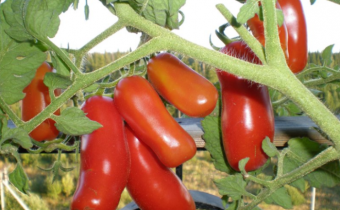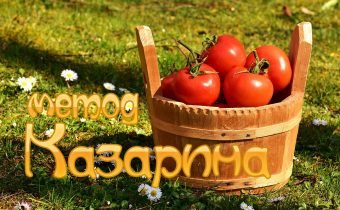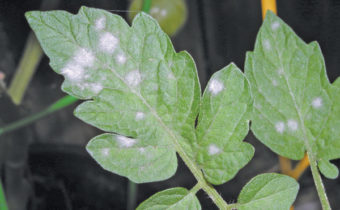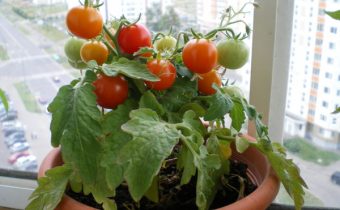How to cover tomatoes in the greenhouse
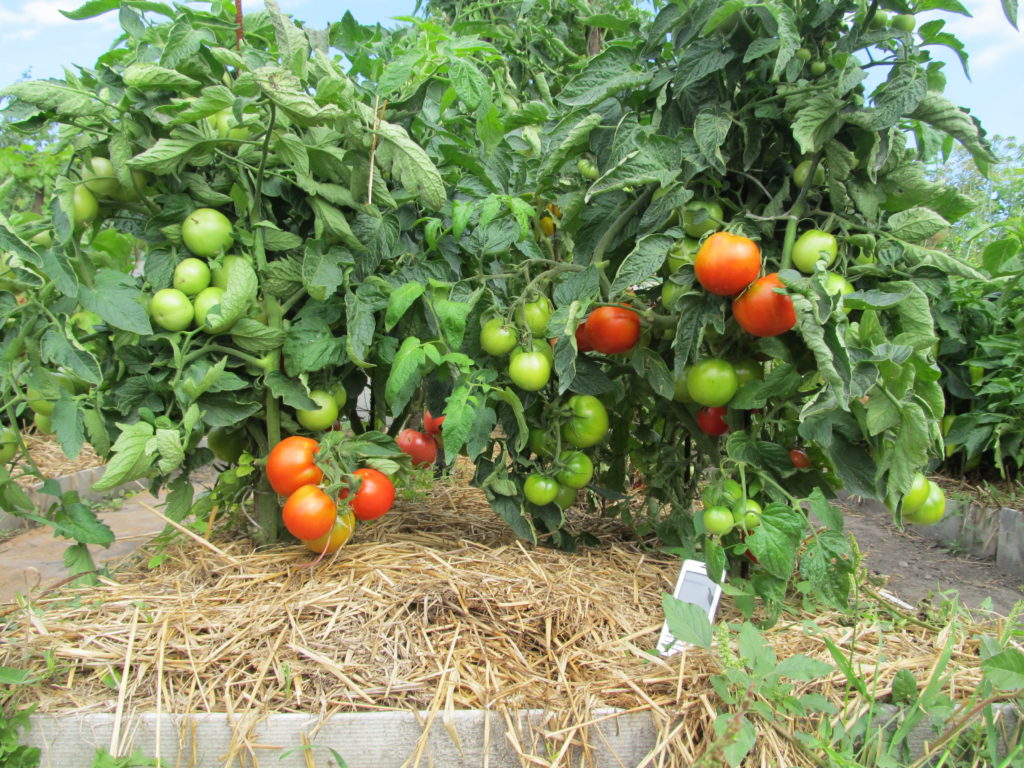
Polycarbonate greenhouses are used by many summer residents for growing tomatoes. Tomatoes are a favorite vegetable crop, for growing which vegetable growers spend not only their time and effort, but also money. It is possible to reduce your expenses on the purchase of fungicides and time to care, fight against diseases with the help of mulch.
Why mulch tomatoes in the greenhouse
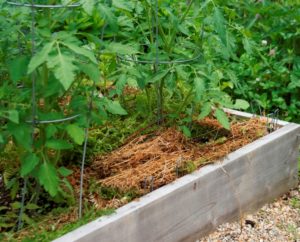
Over the summer, watering greenhouse tomatoes consumes a lot of water. Covering ridges with mulch reduces the evaporation of moisture, this reduces the amount of watering. In the absence of a mulching layer, tomatoes are watered 1 time in 3 days, if present, no more than 1 time in 5 days.
In the soil there is not only useful microflora, it contains the causative agents of fungal diseases of tomatoes. Mulch is an excellent prophylactic against phytophthora, powdery mildew and other diseases. It eliminates the contact of the above-ground part of the tomato with the soil, which reduces the risk of infection of plants. The advantages of mulching include:
- optimal moisture level of the root zone;
- saving time on tillage, it is not necessary to loosen and weed, a crust does not form on the surface of the earth, weeds do not grow under a layer of mulch;
- fertility of greenhouse soil improves.
All the listed benefits of mulching boil down to one result - an increase in tomato yield. Every vegetable grower loves this.
About the features of mulching tomatoes
In greenhouses, the temperature of air and soil is higher than in open ground, so moisture from the soil evaporates more intensively. High humidity is the main cause of fungal diseases. Greenhouse owners use different materials to cover the soil under the tomatoes. Types of materials used:
- natural (organic);
- artificial.
Spring mulch tomatoes in the greenhouse after warming up the soil to 15 ° C. During the season, the organic layer is updated several times, as it is overheating, thinning.
Organic Mulch
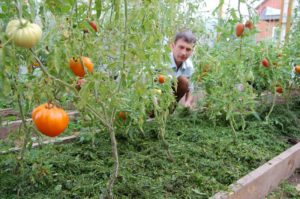
The most affordable option for summer residents. When using organic mulch, soil fertility and its structure are improved. This happens due to the gradual overheating of the mulch layer.
Lawn grass
A good supplier of mulch can be a lawn, it is at many dacha owners. The grass grows quickly, you can mow it in any way: with a trimmer, lawn mower or electric benzokosa.
Before using the cut grass as mulch, it is dried. When using fresh raw materials, the air conductivity deteriorates.
For mulch, you can use any mowed grass. The main thing is that she did not have seeds. Dried raw materials are laid across the ridge in a layer of 5 cm. A smaller thickness will not give a positive result.
Straw
When growing tomatoes in a greenhouse of determinant type, straw is an ideal choice:
- the earth does not overheat;
- moisture does not evaporate;
- fruits and leaves do not touch the ground.
Buy straw is not a problem, it is sold in briquettes and bales. When laying it on a bed, control the thickness of the layer, it should not exceed 7 cm. Violation of this rule will cause compaction of the ground, and may cause decay processes.
Sawdust
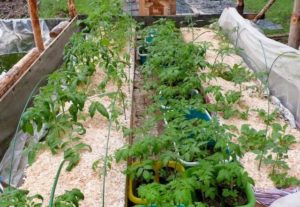
It is not recommended to use fresh sawdust, they take nitrogen from the soil, acidify the soil in the greenhouse.For tomatoes it is better to use waste from the processing of coniferous trees. It takes from 1 to 2 weeks to prepare them, for every 10 kg of raw material they add:
- 1 tbsp. l of superphosphate;
- 120 g of hydrated lime;
- 1.5 Art. l ammonium nitrate.
Ready, darkened sawdust is laid out under a tomato layer of 5-7 cm. It is better to do this in two weeks after transplanting seedlings to a permanent place. Pluses mulch from coniferous sawdust: reduced incidence of tomatoes, tomatoes suffer less from harmful insects.
How to use compost and humus
This type of material should be used carefully so as not to overfeed the bushes of tomatoes. Compost, laid on the soil well fertilized with organic matter and mineral fertilizers, can lead to fattening of tomatoes in the greenhouse. To avoid this, a layer of not more than 3 cm is poured.
Humus (well-rotted manure) is also used as compost. Tomatoes in the greenhouse are mulched with compost (humus) immediately after planting. Seedlings take root faster, less sick. The soil under the mulch for a long time remains wet and loose.
Inorganic raw materials for mulch
Many gardeners prefer inorganic mulch. As arguments in their favor, they call a service life of 2-3 years or more, their ability to maintain the tomato microclimate needed for full development.
Cardboard
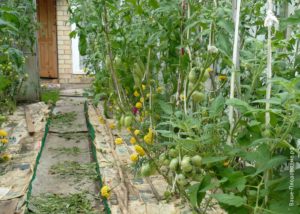
This material is durable, they can close the ridges of tomatoes for several years in a row. It rots in two years. It is convenient to use cardboard, it is easily cut and stacked. Pros from its use:
- inhibits the growth and multiplication of weeds;
- retains moisture;
- does not allow the soil to overheat in the heat, cool at night.
Film
It is more practical to acquire a black film, the thickness of which is not less than 30 microns. Black color because it prevents the growth of weeds. Thickness guarantees long life. It is unprofitable to buy a thin film, it can fail in one season.
If drip irrigation is organized in the greenhouse, the film as mulch will be the best option.
In regions where summer is cool, black is relevant, and for a hot climate two-color types of films are more suitable. They have one side white, it reflects the sun's rays and prevents overheating of the soil, and the other side is black.
PVC film is easy to use. It is cut to the size of the ridge. Lay before planted seedlings. Where the ridge is prepared on the ridge, the film is slit crosswise. Seedlings are planted in the holes, and watering and feeding are carried out in them.
Agrotextiles
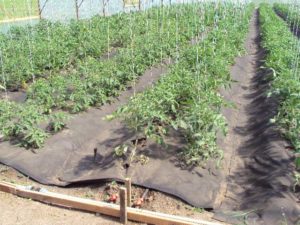
Nonwoven covering materials last the longest. They can be used for 5 seasons. This compensates for the costs of purchasing agrotextiles. In spring, the soil under the tomatoes is covered with black agrofibre. Lay it on the already prepared, fertilized soil.
Tomatoes are planted in the slot. The material is porous, air and water easily penetrate through it, and for weed growth it serves as an obstacle. In the spring in an unheated greenhouse, it does not cool at night and does not allow moisture to evaporate. In summer, in hot weather, white agrotextiles are laid over black material; it protects the roots and the soil from overheating.
Prohibited Materials
Some materials are toxic, so they are not recommended to be used for mulching tomatoes. The ruberoid remaining after construction is better used for other purposes, and not to cover the soil in the greenhouse. It releases harmful substances that can get through the roots in plant tissue.
It is better to refuse peat as mulch, it leads to the oxidation of greenhouse soil.
Any fresh manure (cow, horse) will bring more harm than good to tomatoes:
- may cause root burn;
- stimulate the growth of shoots, leaves and delay the formation of fruits.
When choosing a mulching material for greenhouse tomatoes, it is necessary to evaluate its effectiveness, cost and advantages of the application. Any of the selected options improves the yield of greenhouse tomatoes.


